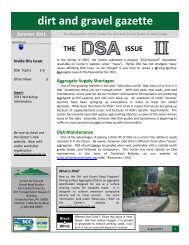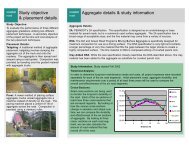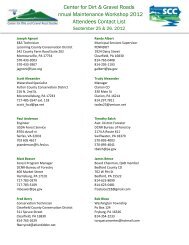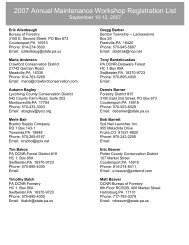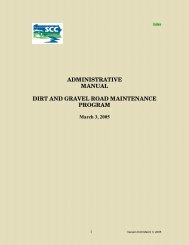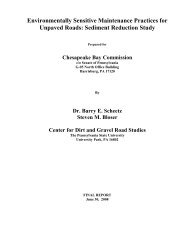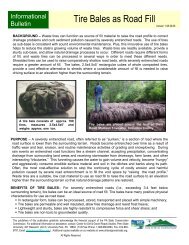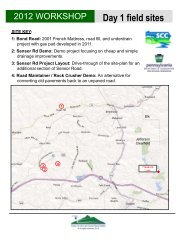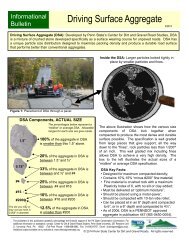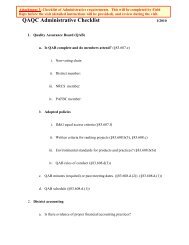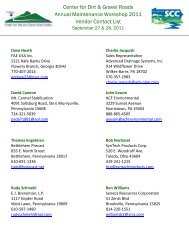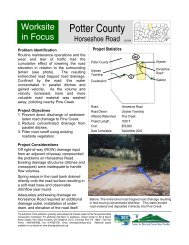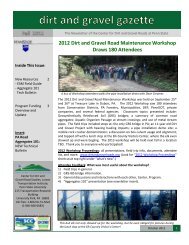Raising the Road Profile Technical Bulletin - Center for Dirt and ...
Raising the Road Profile Technical Bulletin - Center for Dirt and ...
Raising the Road Profile Technical Bulletin - Center for Dirt and ...
You also want an ePaper? Increase the reach of your titles
YUMPU automatically turns print PDFs into web optimized ePapers that Google loves.
<strong>Technical</strong><br />
Why Raise <strong>the</strong> <strong>Road</strong> <strong>Profile</strong>?<br />
Routine road maintenance practices<br />
(surface grading, snow removal,<br />
shoulder cutting, ditch cleaning, etc.)<br />
combined with <strong>the</strong> wear <strong>and</strong> tear of<br />
traffic <strong>and</strong> natural erosive <strong>for</strong>ces have<br />
<strong>the</strong> cumulative effect of lowering <strong>the</strong><br />
elevation of <strong>the</strong> road in relation to <strong>the</strong><br />
surrounding terrain. As <strong>the</strong> road profile<br />
drops, or becomes entrenched, water<br />
draining to <strong>the</strong> road is trapped <strong>and</strong><br />
concentrated in parallel ditches <strong>and</strong> <strong>the</strong><br />
road begins to function as a channel <strong>for</strong><br />
downslope water flow (see photo 1).<br />
Entrenched road profiles make<br />
installation of crosspipes, turnouts <strong>and</strong><br />
o<strong>the</strong>r drainage features to shed water<br />
<strong>for</strong>m <strong>the</strong> road increasingly challenging.<br />
<strong>Raising</strong> <strong>the</strong> road can eliminate <strong>the</strong><br />
persistent maintenance difficulties<br />
associated with an entrenched road.<br />
<strong>Raising</strong> <strong>the</strong> <strong>Road</strong> <strong>Profile</strong><br />
<strong>Bulletin</strong><br />
Version 1.0 1/11/05<br />
1<br />
Draft<br />
Because <strong>the</strong> elevation of <strong>the</strong> road is lower than <strong>the</strong> surrounding<br />
terrain, drainage on <strong>the</strong> road is trapped. As this drainage flows<br />
downhill, its velocity increases. Fast-moving water washes road<br />
material away <strong>and</strong> means more frequent road maintenance.<br />
Typical Requirements<br />
• Low-cost fill material that is nearby. Commonly used fill materials include: native shale, rock or<br />
mining spoil, bank run gravel, concrete or demolition waste, tire shreds, ground glass, spent<br />
s<strong>and</strong> from s<strong>and</strong>blasting, <strong>and</strong> coal combustion waste.<br />
• Hauling of material to <strong>the</strong> site.<br />
• Grader or bulldozer to place <strong>and</strong> shape fill material.<br />
• Geo-textile fabric to streng<strong>the</strong>n <strong>the</strong> road base (not always necessary).<br />
• Compaction equipment to compact <strong>the</strong> fill in 8” to 12” lifts. Compaction is critical. A large static<br />
roller, vibratory roller or sheep’s foot roller should be used to thoroughly compact each lift of fill.<br />
• Durable road surfacing material to cap <strong>the</strong> newly filled road surface.<br />
Important Considerations<br />
• Select fill material carefully. Some materials may need permits or require special h<strong>and</strong>ling.<br />
• When adding fill material, it is ideal to raise <strong>the</strong> road enough that drainage is restored to a<br />
natural condition. In o<strong>the</strong>r words, ditch flow is eliminated from ei<strong>the</strong>r <strong>the</strong> downslope side of <strong>the</strong><br />
road or both sides of <strong>the</strong> road (depending on topography) allowing road drainage to sheet flow<br />
off <strong>the</strong> road into <strong>the</strong> surrounding l<strong>and</strong>scape.<br />
• <strong>Raising</strong> <strong>the</strong> road profile coincides well with installation of underdrain. Please see <strong>the</strong><br />
Underdrain In<strong>for</strong>mational <strong>Bulletin</strong> <strong>and</strong> <strong>the</strong> Installing Per<strong>for</strong>ated Underdrain <strong>Technical</strong> <strong>Bulletin</strong> <strong>for</strong><br />
more in<strong>for</strong>mation.<br />
The publishers of this publication gratefully acknowledge <strong>the</strong> financial support of <strong>the</strong><br />
Pennsylvania State Conservation Commission. For additional in<strong>for</strong>mation or<br />
assistance, contact: <strong>Center</strong> <strong>for</strong> <strong>Dirt</strong> & Gravel <strong>Road</strong>s Studies, Penn State University,<br />
207 Research Unit D, University Park, PA 16802 (Toll-Free Phone: 1-866-668-6683,<br />
Fax: 814-863-6787, Email: dirt<strong>and</strong>gravel@psu.edu). Additional copies available on our<br />
website at: www.dirt<strong>and</strong>gravelroads.org
Draft<br />
Construction Sequence<br />
Be<strong>for</strong>e: An entrenched road traps road drainage on<br />
<strong>the</strong> road in parallel ditches. This is a situation that<br />
requires constant maintenance. <strong>Raising</strong> <strong>the</strong> road<br />
eliminates <strong>the</strong> persistent maintenance associated with<br />
a road that is lower than <strong>the</strong> surrounding terrain.<br />
ditch<br />
flow<br />
be<strong>for</strong>e<br />
Cross-section #1<br />
During: Prep <strong>the</strong> existing road base with proper crown<br />
be<strong>for</strong>e adding fill material. Place fill material in <strong>the</strong> road<br />
profile in 8” to 12” lifts. Each lift of material should be<br />
placed with proper crown of ½” to ¾” per foot.<br />
Compact each lift of material to ensure a solid road<br />
base. Geo-textile fabric can be used in between lifts of<br />
material to add strength to <strong>the</strong> road base. Whenever<br />
possible, add enough fill material to raise <strong>the</strong> elevation<br />
of <strong>the</strong> road to restore natural drainage patterns.<br />
1 st lift of fill<br />
during<br />
Cross-section #2: The existing road base is re-shaped<br />
with proper crown. The first lift of fill material is placed,<br />
crowned <strong>and</strong> compacted.<br />
2 nd lift of fill<br />
after<br />
1 st lift of fill<br />
Cross-section #3: The second lift of fill material is laid<br />
on top of <strong>the</strong> first lift, crowned <strong>and</strong> compacted.<br />
After: Place aggregate on <strong>the</strong> fill material. Because<br />
<strong>the</strong> fill has been crowned or shaped properly, <strong>the</strong><br />
aggregate will retain its shape <strong>and</strong> facilitate sheet flow<br />
off <strong>the</strong> road.<br />
sheet<br />
flow<br />
Cross-section #4<br />
Filling <strong>the</strong> road: be<strong>for</strong>e, during, <strong>and</strong> after. Here<br />
native shale was used to fill <strong>the</strong> road <strong>and</strong> eliminate<br />
<strong>the</strong> ditch on both sides of <strong>the</strong> road. Driving surface<br />
aggregate (DSA) was placed on top of <strong>the</strong><br />
prepared shale surface.<br />
This publication is available in alternative media upon request. The Pennsylvania State University is committed to <strong>the</strong> policy that all persons shall have equal access<br />
to programs, facilities, admission, <strong>and</strong> employment without regard to personal characteristics not related to ability, per<strong>for</strong>mance, or qualification as determined by<br />
University policy or by state or federal authorities. The Pennsylvania State University does not discriminate against any person because of age, ancestry, color,<br />
disability or h<strong>and</strong>icap, national origin, race, religious creed, sex, sexual orientation, or veteran status. Direct all affirmative action inquiries to <strong>the</strong> Affirmative Action<br />
Office, The Pennsylvania State University, 201 Willard Building, University Park, PA 16802-2801; tel. (814) 863-0471; TDD (814) 865-3175. U.Ed #RES-01-50.



